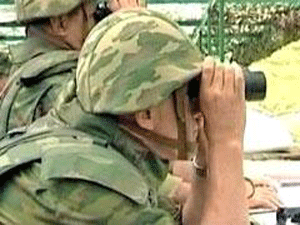Teona Akubardia, Military Analytic Group “Heri”
In 2006, the parliament of Georgia adopted a new law on “Military Reserve Service” based on which the defense ministry of Georgia, more precisely the National Guardia started training of reservists first in the history of independent Georgia.
According to the law, the reserve of the military forces was being created during the mobilization, military or/and urgent situations, or in some other extraordinary situations or because of national security interest to support the military forces of the country. The contingent of the recruiters for the military reserves was too large and the president of Georgia Mikheil Saakashvili stated that the number of reservists had to reach 100 000 by 2012.
About 28 000 citizens took obligatory military reserve training before the war in August of 2008. Besides that, the parliament of Georgia introduced some changes to the security conception to put the law in motion after what the army shifted from the territorial defense to total and unconditional defense. According to the law, person was recruited to the military reserve once a year for 18 days and the service was divided in three categories: 1) active reserve which aimed to maintain the military readiness and readiness for mobilization; 2) recruiters for the reserve of the National Guardia which aimed to participate in the military operations in the arrears of the military forces and participation in the liquidation of the particularly urgent situations; 3) individual reserve whose main purpose is rotation and supplementation of the active subunits of the armed forces. The students created the main part of the reservists who had to take three reserve trainings in accordance to the law; after that they were discharged from the responsibility of obligatory military service.
The war of August in 2008 exposed the inefficiency of the reserve service. The defense ministry started to analyze the results of their mistakes and in October of 2009, they introduced the new vision of the National Guardia about the reserve system. The new vision analyzed the mistakes made in the system. The Guardia listed several reasons of the mistakes: insufficient training of reservists for the military activities which was caused by the short time of the reserve training; lack of military knowledge among most of the recruiters because they were the students of various institutions of Georgia who had not taken any military training before; they focused on the number of reservists and not on the quality.
(For example: in 2007-2008 28 000 reservists were trained which was too many for the time of training; lack of management resources in brigades and battalions (5 military servants were put in charge of 500 reservists) and inefficient general management).
In order to eradicate the problems, the National Guardia stated in the new vision that they would focus on the quality and efficiency instead on the number of reservists; motivated and qualified reservists play important role in the development of the armed forces of Georgia, in the defense of the territory and population of the country.
According to the project, the reserve will be divided into two parts – obligatory and voluntary. The former was envisaged for the people from the age of 27 to 45 who are able to take military service; and the voluntary service was designed for every person over 27 years. The people who took reserve service in 2007-2008 can also apply for the voluntary service.
According to the new vision, the reserve training would have lasted 45 days and the number of the reservists on the first stage would have been no more than 3 000. 1 100 out of them would have set up two military battalions in the Western and Eastern Georgia. 550 reservists would have been in each battalion.
Permanent personnel of 73 military servants would have been in each battalion for the management and supervision of the battalion. The battalions would have composed the brigades of the National Guardia which would have had its HQ and sections (with doctors, engineers, communication specialists).
As for the rest personnel of the brigade, they had to recruit volunteers during the military situation, distribute weapon among them, carry out corresponding registration of the recruiters and assist the civil authority to accept and accommodate IDPs. The same project envisaged the reserve training bases in Tbilisi, Senaki and Telavi.
The vision was sent to the non-governmental sector, the parliament of Georgia and the diplomatic corps accredited in Georgia for the discussion in October-December of 2009; however, the future of the vision ended after the former commander of the National Guardia Zura Arsoshvili occupied the position of the Shida Kartli regional governor.
On July 28, 2010 the president of Georgia Mikheil Saakashvili stated during his meeting with the high-ranking officials of the defense ministry of Georgia that Georgia needed “total defense” when every village would be able to defend itself. “Small groups of well-trained people should be in every village, in every residential area with minimal amount of weapon in order to enable everybody to defend its homeland, village, street, city and region,” said the president.
The statement of the president abruptly opposed the new vision of the National Guardia which focused on the quality rather than on the number of reservists. The parliament of Georgia received the new draft-law on the Reserve Military Service on June 26, 2010 which envisaged 45-military training of reservists. However, nothing was mentioned about the number and training program of the reservists. The parliament stopped discussion of the draft-law because it was not well-designed and on July 21, the parliament introduced new amendment into the old law on the military reserve service. They amended the Article 6 which estimated the number of training days -18 into 45 days.
Based on the abovementioned circumstances, today, when the National Guardia of Georgia has not had the commander for two months already, when it does not have any vision about reservists training and there is no training program for the 45 days, it is obscure how the government of this country and the National Guardia is going to recruit the reservists, how many people will be recruited per year, how much will be spent on this project and when the recruitment process will launch. Besides that, it is strange whether the National Guardia is able to train the large number of reservists and how well the experience of our army and the army of the NATO partner states are envisaged in this new initiative.
The current situation exposes that the development of the armed forces and the National Guardia does not happen in accordance to the preliminary worked out plan which could relay on the renewed strategic documents (security conception, military strategy, etc); it also demonstrates that the military authority of the country has not learned the lessons of the Georgian-Russian war of August, 2008 that might be very dangerous for the security of the country in future.
News
December 13, 2023
Ethnic minorities outside the peace dialogue
November 6, 2023
‘Peace’ agenda of political parties
Popular
Articles
February 13, 2024




